- Discover how Angular micro frontends help teams scale faster, deploy independently, and modernize apps without a full rewrite.
- Learn the proven strategies, tools, and real-world examples that show how modular architecture turns complex Angular monoliths into agile, scalable systems.
Breaking the Monolith with Angular Micro Frontends: How to Scale Smarter in 2025
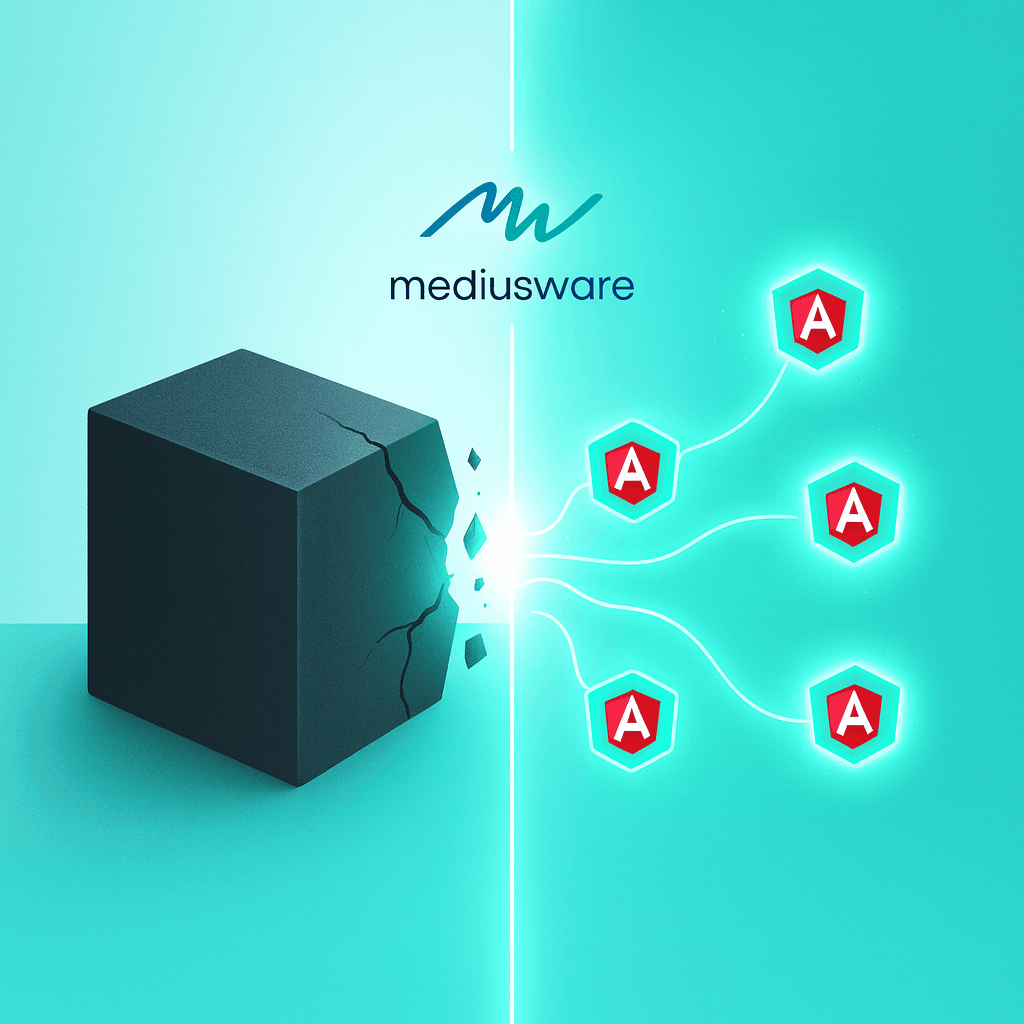
It usually starts the same way.
Your Angular app was once fast, clean, and easy to manage. But as new features pile up, your builds slow down, merge conflicts multiply, and deployments begin to feel like production puzzles. Someone says, “Maybe it’s time for a full rewrite.”
You don’t need a rewrite.
You need a smarter way to scale.
That’s where Angular micro frontends come in. Instead of managing one massive codebase, you split the frontend into smaller, independently deployable apps, each owned by a team that moves at its own speed.
In 2025, this shift isn’t a trend; it’s a necessity. As enterprises modernize, micro frontends are becoming the backbone of scalable, cloud-ready Angular systems.
Why Monoliths Slow You Down
Most teams don’t realize their monolith is hurting productivity until it’s too late. What started as one clean app evolves into a dependency maze. A change in the checkout page breaks the admin dashboard. A quick patch triggers a 40-minute build.
The real bottleneck? Coordination, not code.
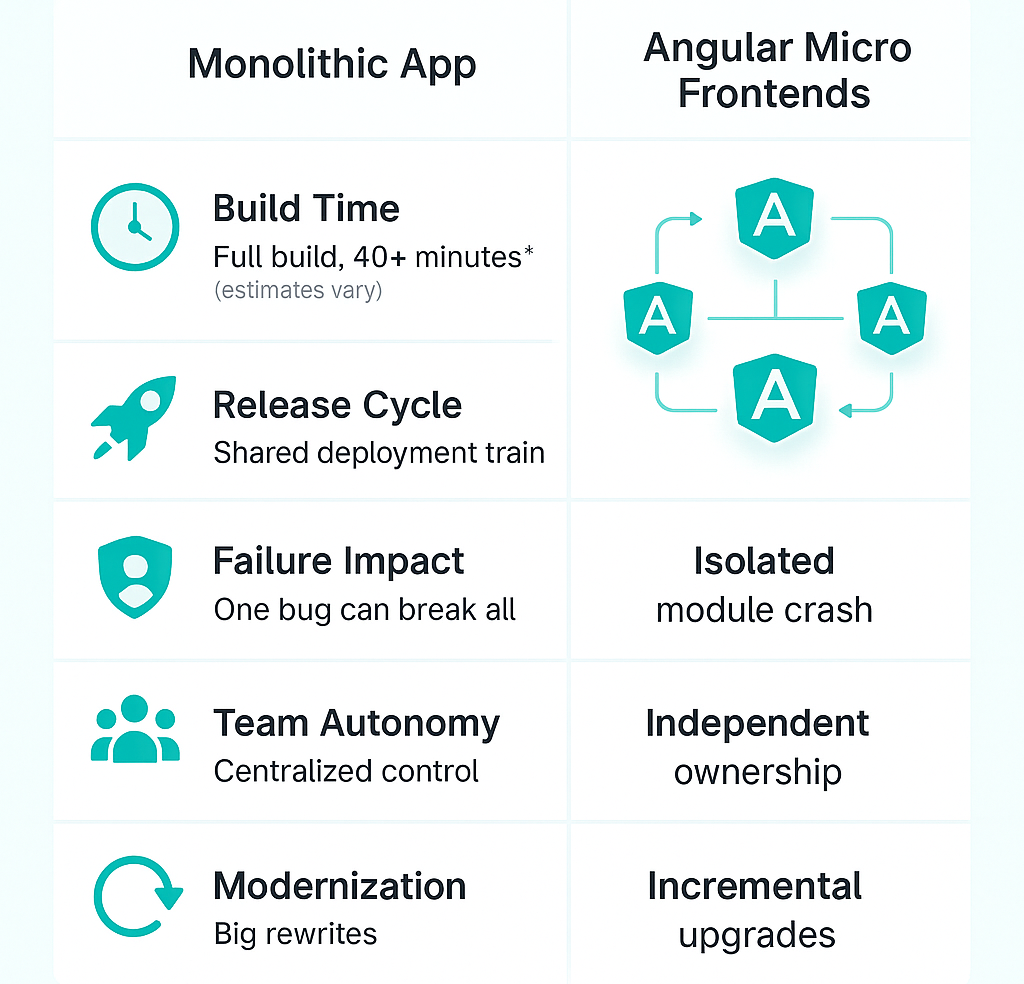
As Manfred Steyer, Angular architect and founder of ANGULARarchitects.io, puts it:
“The biggest challenge with monoliths isn’t performance, it’s how they slow down teams. The larger the app, the more every deployment becomes a shared risk.”
Common pain points:
- One release blocks all others.
- A single bug can hold up an entire sprint.
- Build pipelines waste hours on code that wasn’t even touched.
- Scaling teams doesn’t scale delivery.
For fast-growing businesses, that’s costly. Time-to-market slows, release cycles break rhythm, and engineers spend more time coordinating than coding.
What Are Angular Micro Frontends?
Think of your frontend like a large organization. A monolithic app is one giant office — crowded, noisy, and hard to reorganize. A micro frontend architecture is like moving to multiple offices, each focused on one department, all working toward the same goal.
In Angular, that means splitting the app into small, self-contained modules that work together at runtime inside a shared shell. Each team owns its domain, whether it’s checkout, analytics, or user settings.
Real-World Example:
Spotify uses a similar approach. Each section, playlists, recommendations, settings, is built and deployed independently, allowing teams to innovate faster without blocking each other.
For Angular applications, frameworks like Nx and Module Federation make this modular approach possible without sacrificing consistency.
The Business Case for Angular Micro Frontends
Micro frontends aren’t just a technical upgrade, they’re a business enabler.
1. Scalability with Autonomy
Each domain team manages its own module, so growth doesn’t slow down development. This model is perfect for enterprises scaling engineering teams across regions.
2. Faster Release Velocity
Every micro app can deploy independently. The Payments team doesn’t need to wait for User Profile to finish testing. According to ThoughtWorks’ 2025 Tech Radar, companies using modular frontend delivery see up to 45% faster release cycles.
3. Reduced Risk Through Isolation
If one module fails, it won’t crash the entire system. This improves resilience, uptime, and recovery times.
4. Incremental Modernization
You can modernize feature by feature. No downtime, no “big bang.” Just continuous evolution.
5. Cost Efficiency
Smaller builds mean shorter pipelines and lower cloud resource consumption. It’s scaling smart, not scaling hard.
The Technical Blueprint
Let’s break down how Angular micro frontends work under the hood.
Module Federation: Independent Yet Connected
Module Federation allows each team to package its module as a standalone unit that can be dynamically loaded into a host shell.
// webpack.config.js
name: 'checkoutApp',
remotes: {
profile: 'profileApp@http://localhost:4201/remoteEntry.js'
}
This means the Profile team can ship updates without waiting for the Checkout team’s build to pass.
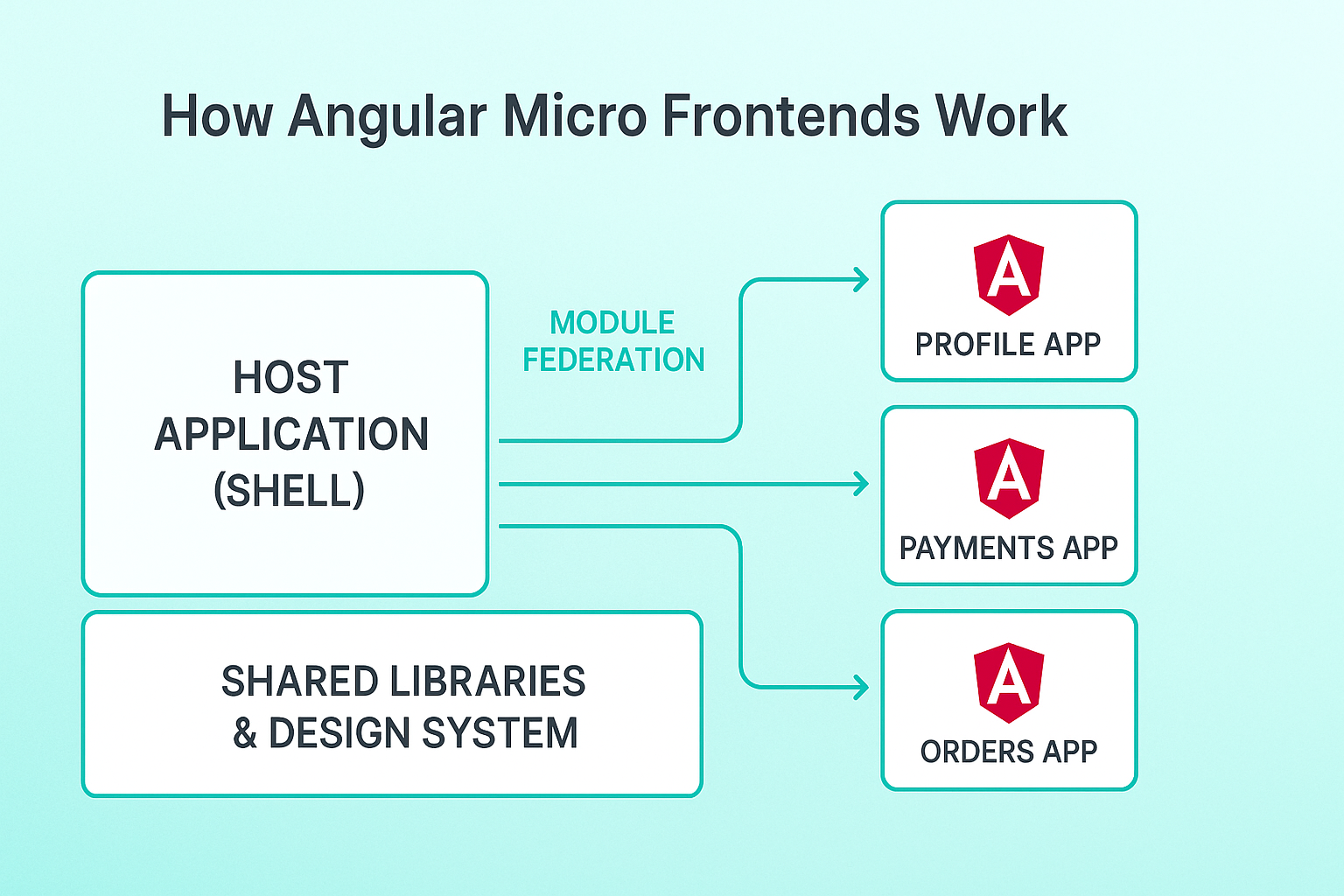
Real-World Example:
E-commerce platforms like Zalando use module federation to let different teams release features daily while maintaining a unified UI.
“Independent deployability is the secret weapon of modern web teams,” says Zack Jackson, co-creator of Webpack Module Federation.
“It turns release trains into release freedom.”
Lazy Loading: Performance That Scales
Even modular apps can become heavy if every bundle loads at once. Lazy loading ensures only the code needed for a route is fetched.
When a user opens the “My Orders” page, only that module loads. The result? Faster initial render, better Core Web Vitals, and lower bandwidth use.
Case in point: Google Pay’s web team improved Time to Interactive by 38% after applying lazy loading across multiple micro frontends.
Shared Libraries and Governance
Without consistency, autonomy becomes chaos. Shared libraries and version control ensure teams don’t drift apart.
Key practices:
- Centralize UI and utilities in versioned libraries.
- Use Nx workspaces or private npm registries.
- Automate dependency validation through CI checks.
As Monorepo advocate Victor Savkin (co-founder of Nx) explains:
“Micro frontends without governance become a distributed mess. Nx keeps autonomy while enforcing shared structure.”
Governance isn’t about rules, it’s about reliability. It keeps your UI consistent, your versions stable, and your brand cohesive.
Routing and Shared State: Keeping It Unified
Even if your code is split, the user experience must remain seamless. Routing and shared state management make that possible.
| Concern | Owner | Implementation |
| Routing | Host app | RouterModule.forRoot() |
| Local routes | Remote apps | RouterModule.forChild() |
| Auth & tokens | Shared store | API-based subscription |
A shopper logs in once, adds items, and checks out without realizing three separate teams built those flows.
The golden rule: federate the code, not the experience.
Choosing the Right Implementation Path
Not all teams need the same setup. Pick what fits your organization’s size and maturity.
| Model | Best For | Complexity | Example Tools |
| Single-spa | Cross-framework ecosystems | High | Webpack + Angular Elements |
| Nx | Pure Angular setups | Medium | Nx CLI + Module Federation |
| Custom Loader | Legacy or regulated systems | High | Custom integration |
Pro Tip:
Start small. Choose one stable domain (like analytics or admin) to modularize first. Measure build time, performance, and release cycle improvements before scaling across teams.
CI/CD and Governance: The Invisible Backbone
Micro frontends thrive when pipelines are fast, isolated, and automated.
A well-structured CI/CD pipeline should allow each team to deploy within 20 minutes from commit to production.
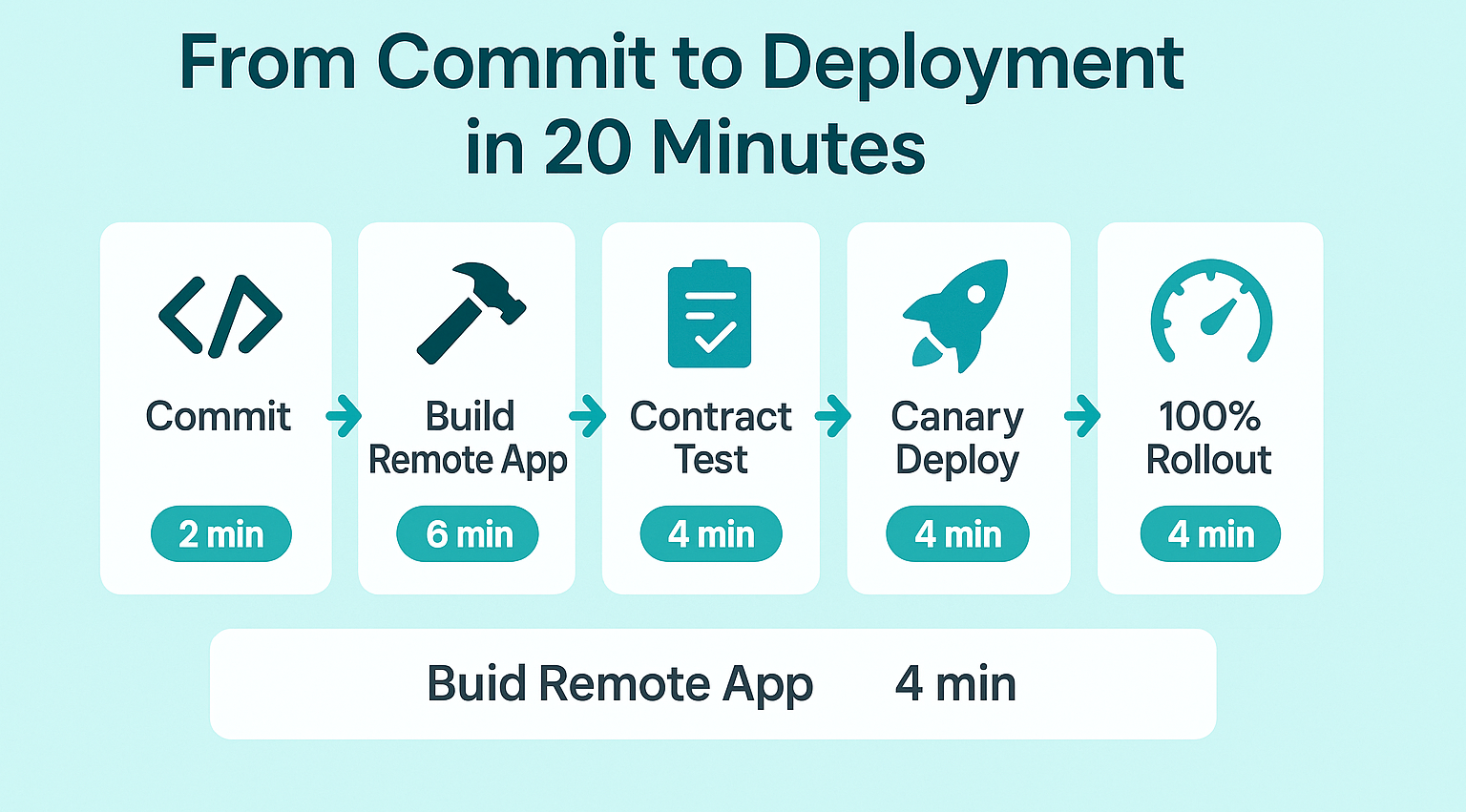
Example Flow:
- Static checks and tests finish in under 2 minutes.
- Each remote app is versioned independently with semantic tags.
- A contract test validates compatibility with the host.
- Canary deploys release to 1% of users first.
“Micro frontends aren’t about breaking apps apart, they’re about freeing delivery,” says Martina Kraus, Google Developer Expert (Angular). “If your CI/CD can’t keep up, autonomy just becomes chaos.”
Governance adds the guardrails that prevent that chaos: shared templates, performance budgets, and a unified design system.
Common Pitfalls and How to Avoid Them
Every architecture has trade-offs. Here’s how to avoid the common traps.
| Pitfall | Why It Happens | How to Fix It |
| Bundle Bloat | Duplicated dependencies | Use dependency-check scripts and nightly bundle diff reports |
| Security Gaps | Misconfigured OAuth | Centralize auth with shared middleware |
| Scattered Monitoring | Unaligned logging | Use a shared Grafana board tagged by team and module |
| UX Drift | Independent styling | Maintain a design system in a shared library |
Real-world reminder: A great micro frontend setup feels invisible to the user.
If it feels “modular,” something went wrong.
Case Study: Incremental Modernization in Action
A major EdTech company running a large Angular 1.x platform faced long release cycles and brittle builds.
Rewriting wasn’t feasible, as millions of users depended on daily uptime.
Instead, they moved gradually:
- Adopted an Nx monorepo for shared governance.
- Implemented Module Federation for independent builds.
- Used Single-spa as the host container for feature-based routing.
Within six months, they achieved:
- 60% faster build times
- Independent deployments per module
- UI consistency across all features
The team went from one release every two weeks to multiple daily updates, without downtime.
Checklist: Is Your Team Ready for Micro Frontends?
| Area | Key Question | Ready? |
| Teams | Do teams fully own their features? | ☐ |
| Governance | Is a platform team in place? | ☐ |
| Tooling | Are Nx or Single-spa configured? | ☐ |
| Observability | Are logs centralized? | ☐ |
| Culture | Is leadership aligned on modular delivery? | ☐ |
If your teams don’t yet check most boxes, start with governance first, it’s the foundation for sustainable autonomy.
The Big Picture
Breaking a monolith isn’t about code, it’s about control.
It’s about enabling teams to move independently without breaking the whole system.
When architecture, governance, and culture align, Angular micro frontends deliver measurable wins: faster releases, cleaner ownership, and scalable delivery.
Modernization doesn’t require starting over. It requires building smarter.
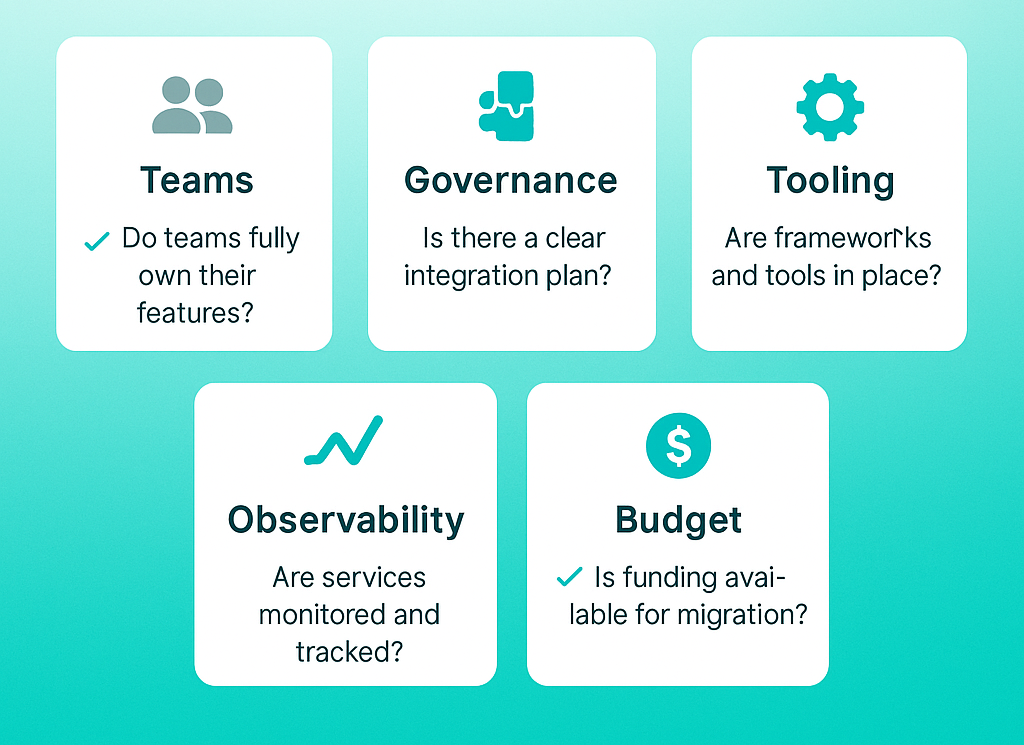
At Mediusware, we help engineering teams adopt modular architectures that scale with their business, one domain at a time.
Ready to move from tangled monoliths to modular freedom?
Let’s build your next-generation Angular architecture together.

Featureblogs
Relatedblogs
Authorblogs
Get the best of our content straight to your inbox!
By submitting, you agree to our privacy policy.


